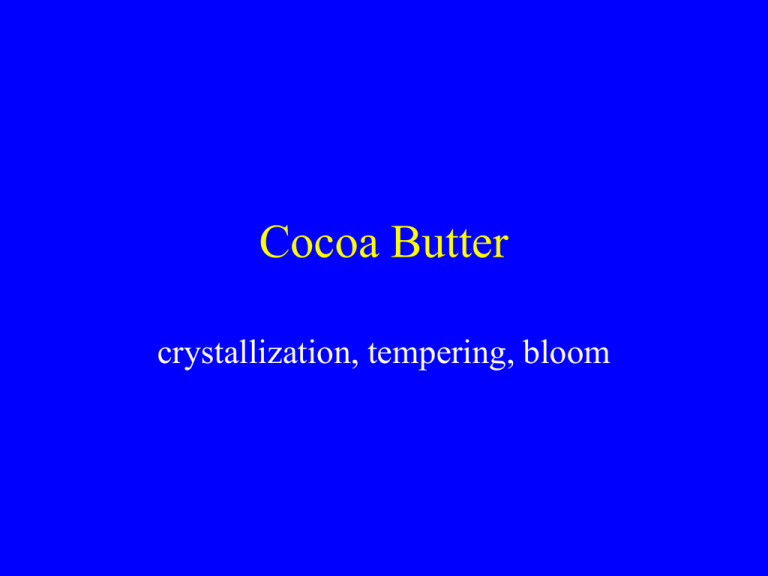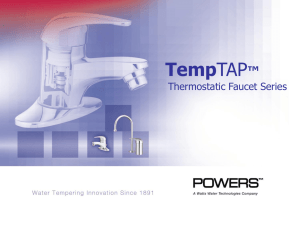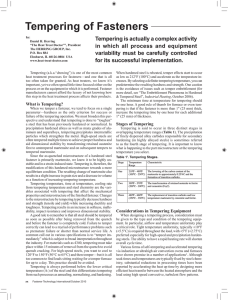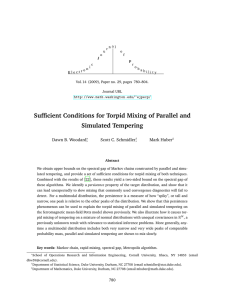Tempering - courses.psu.edu
advertisement

Cocoa Butter crystallization, tempering, bloom Plan • Lipid structure, crystallization & polymorphism • Tempering theory & practice • Bloom Fatty Acids Stearic acid 18 carbon carboxylic acid linear molecule Oleic Acid 16 carbon carboxylic acid single double bond puts a “kink” O C HO Fatty Acids in Cocoa Butter 26 wt% 16:0 Palmitic acid 34 wt% 18:0 Stearic acid 35 wt% 18:1 Oleic acid …plus about 5 others Triglycerides take on a tuning fork configuration Homogeneous Nucleation T>Tmelt True melt T=Tmelt T<<Tmelt supercooling Crystal embryos Crystal lattice Heterogeneous Nucleation T>Tmelt True melt T=Tmelt Nucleation T<Tmelt less supercooling Crystal lattice Solid Fat Content 100% solid • SFC is a function of temperature • SFC is a function of temperature history • SFC is a function of time • SFC is a function of composition 100% liquid cold Temperature hot Polymorphism Molecular packing can vary by angle of tilt... …and by chain packing Consequently there are several types of triglyceride crystal I sub- 17.3oC II 23.3oC III '2 25.5oC IV More dense '1 V VI Higher MP o 27.3 C o 33.8 C o 36.3 C More desirable Key Facts • • • • • • Desirable forms have a high melting point The higher melting point, the more stable More stable fats are more dense More stable forms are slow to form Like crystals will grow from like Cocoa butter can convert from a less to more stable form • As the oil cools the fat molecules slow down • Eventually try to “stop” in contact with another molecule (crystal lattice) • It takes time to get into optimal position (most dense) • Pre-existing nuclei can help form a template Rapid cooling leads to a less well ordered structure! Cocoa butter • Cocoa butter is largely triglycerides • There has several stable crystal polymorphs • Good chocolate can only be made from the stable crystals Tempering Tempering is a time-temperature process ensure the formation of chocolate in the right crystal habit In practice this means we want 1-2% solids at ~32oC which will act as seeds when the melt is cooled Why o 32 C? I sub- 17.3oC II 23.3oC III '2 25.5oC IV '1 V VI o 27.3 C o 33.8 C o 36.3 C Tempering • Why temper? – – – – Demolding Snap Gloss Resistance to bloom • Temperature and time control Tempering Sequence temperature 50oC Melt Cool - no crystallization Form mix of crystals Melt out unstable polymorphs 32oC 30-32oC 27oC time Tempering Practice • Hand tempering • Batch tempering • Continuous tempering • Temper meters Hand Tempering • Melt fat • Pour melt onto slab and work with spatulas • Return semicrystalline batch back to warm melt • Mold chocolate Melt Cool - no crystallization Form mix of crystals Melt out unstable polymorphs Kettle Tempering Melt Cool - no crystallization Form mix of crystals Melt out unstable polymorphs 3-stage Tempering Machine Tempering • Tempering is a process to ensure the formation of stable crystals • Tempering is a time-temperature process • Tempering can be done as a batch or continuous process • Degree of temper can be measured from a cooling curve What is bloom? • White “moldy” appearance at the surface • Major reason for product failure • NOT a health hazard Often caused by large fat crystals growing from the surface and scattering light Types of Bloom • High temperature bloom • Low temperature bloom • Fat migration bloom High Temperature Bloom • Fat is stored hot enough to melt (~35oC) • Fat resolidifies and is no longer tempered • Untempered chocolate rapidly grows bloom U se a high melting fat if you can’t be certain of distribution temperature Low Temperature Bloom • In well tempered chocolate stored below its melting point • Associated with V to VI transition • Occurs faster at high temperatures (esp. if temp. cycles) Reduce storage temperature Migration Bloom • The movement of fat from an enrobed center to the surface • Dissolves some cocoa butter and carries it to the surface • Cocoa butter recrystalizes at the surface How to avoid bloom • • • • Temper the chocolate properly Store cool Add butter-fat Add emulsifier (e.g. sorbitan monostearate) Bloom • A moldy white deposit on the surface • Large fat crystals formed by migration and recrystallization • Not a health hazard but it is a cause for product rejection • Avoid by good tempering and controlled storage







